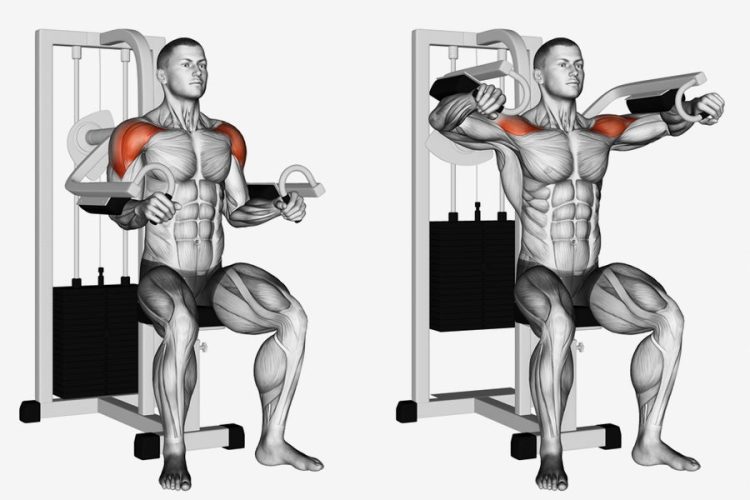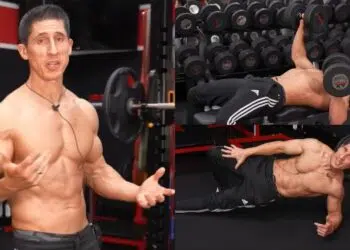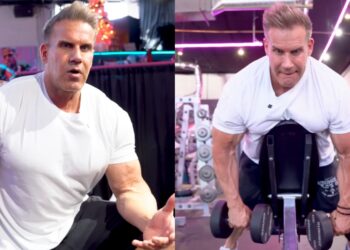What do Superman, Batman, the Incredible Hulk, Thor, and most other macho superheroes have in common? All of them have round, big, and full shoulders. You’ll never see a superhero that oozes masculinity with sloping shoulders. We’d go as far as to say that most of these heroes have a machine lateral raise in their training equipment arsenal.
Don’t get us wrong; this exercise isn’t reserved for male superheroes. Anyone who adds the machine lateral raise to their training routine could build shoulders that look like they are wearing football shoulder pads under their shirt.
Shoulder Anatomy
Your deltoids consist of three muscles:
- Anterior Deltoids: They are located at the front of your shoulders and help with shoulder flexion, which includes raising your arm in front of your body as you would during a front raise.
- Lateral Deltoids: They lie between the anterior and posterior delts. The middle delts also help with shoulder flexion but are mainly responsible for shoulder abduction or when you bring your arms away laterally from the midline of your body, as in a lateral raise.
- Posterior Deltoids: Posterior deltoids help move your arms backward. Furthermore, they are used in many pulling movements and are important shoulder stabilizers.
The machine lateral raise can help build boulder shoulders and accentuate your V-taper. The exercise can add to the broad shoulder illusion, making your waist look smaller. Plus, they can aid in building 3D shoulders and improving your aesthetics.
The machine lateral raise is a dumbbell lateral raise variation. Since this exercise is performed on a machine while seated, it helps better isolate your deltoids and delivers muscle-ripping pumps by eliminating the use of momentum.
Level Up Your Fitness: Join our 💪 strong community in Fitness Volt Newsletter. Get daily inspiration, expert-backed workouts, nutrition tips, the latest in strength sports, and the support you need to reach your goals. Subscribe for free!
Many people cheat on the dumbbell side lateral raise by swinging their torso back and forth or jerking their knees to raise the dumbbells to shoulder level. However, since the machine lateral raise is performed while seated, both these cheating methods are rendered useless.
Muscles Worked: Machine Lateral Raise
Given below are the primary and secondary muscles trained by this exercise:
- Primary Muscle: The middle or lateral deltoids are the primary target muscle in this exercise.
- Secondary Muscle: As the anterior delts lie at the front of your shoulders, you cannot keep them out of side lateral exercises.
How To Perform the Machine Lateral Raise
This is how to perform the machine lateral raise using the correct form:
- Select a weight that will allow you to perform 8-12 reps on this exercise.
- Adjust the seat height so the pads touch the bottom of your upper arms and elbows at the starting position.
- Sit upright while maintaining your back’s natural arch, plant your feet flat on the floor, and grab the machine’s handles.
- Keep your neck neutral throughout the exercise and look straight ahead.
- By moving at your shoulders, push the weights up until your upper arms are almost parallel to the floor.
- Pause and contract your shoulders at the top.
- Slowly return to the starting position.
- Repeat for recommended reps.
Machine Lateral Raise Tips
Make the most of this exercise using the following tips:
- To keep constant tension on your lateral delts throughout this exercise, ensure you are not letting the weight stack at the bottom of the movement.
- Follow the perfect form to get the best bang for your buck. Since this is an isolation exercise, you don’t need to go super heavy.
- Use a full range of motion and pause at the top for a couple of seconds for optimal muscle fiber recruitment.
- Don’t round your back, and keep your chest up and core tight throughout the exercise.
- Keep your neck steady throughout the movement. Do not look up or down.
- Some gyms have a standing lateral raise machine with extended handles that mimic the standing dumbbell lateral raise. Make sure you’re not using momentum by jerking your knees or bending back and forth while using this machine.
Common Mistakes: Machine Lateral Raise
Here are some of the most common mistakes lifters commit while performing the machine lateral raise:
1. Rushing Through the Exercise
Since this isolation exercise requires using relatively light weights, exercisers tend to rush through their sets. However, they leave gains on the table in doing so.
Use the light weights as an opportunity to contract your delts with every rep. Focus on establishing a mind-muscle connection. Keep the reps slow and controlled, and feel free to use advanced training principles like intraset stretching and rest-pause sets to get the best bang for your buck.
2. Raising Arms Above Shoulder Level
At the top of the movement, your elbows should be around your shoulder level. Lifting your elbows higher than shoulder level can result in trapezius recruitment, taking tension away from your middle delts.
3. Incorrect Sitting Position
Some lifters sit way too back on the seat or set it too high, putting them in a position where the machine pads are set against their forearms. Using your forearms to push the weight will result in lower arm recruitment.
Additionally, you need to ensure that you are not rounding your back while performing the movement as it can lead to upper back stimulation.
4. Going Too Heavy
If you find yourself leaning back while performing this exercise, you’re probably going too heavy. Drop the weights and use a strict form to annihilate your middle delts. Going too heavy can result in greater front delt recruitment and strain your shoulder rotator cuffs.
Don’t lift the weights for the sake of it. Keep your reps slow and controlled for optimal muscle stimulation. Use a 2:2:2:0 rep tempo for a nasty shoulder pump. In this method, you’ll spend two seconds on the concentric motion, two seconds of contraction at the top, two seconds on the eccentric, and no rest at the bottom.
Benefits: Machine Lateral Raise
Adding the machine lateral raise to your exercise regimen entails the following benefits:
1. Isolates Middle Delts
The anterior deltoids are involved in pressing exercises like the overhead shoulder press, bench press, and incline bench press. However, the lateral delts do not get the same amount of stimulation in these exercises, which could lead to muscle and strength imbalances.
Middle delt isolation exercises like the machine lateral raise and dumbbell side lateral raise can help improve muscle symmetry, balance, and proportions.
2. Mind-Muscle Connection
Since this is an isolation exercise, the machine lateral raise lets you zero down on your shoulders, helping you achieve a mind-muscle connection and better pumps.
Level Up Your Fitness: Join our 💪 strong community in Fitness Volt Newsletter. Get daily inspiration, expert-backed workouts, nutrition tips, the latest in strength sports, and the support you need to reach your goals. Subscribe for free!
3. Improves Aesthetics
Single-joint exercises let you focus on a single muscle group. Since you are training a lone muscle group, it’s easier to build a mind-muscle connection and achieve hypertrophy. Stay in the 8-12 rep range for the most optimal muscle-building results. [1]
Plus, as mentioned above, bigger and rounder deltoids can improve your overall aesthetics by accentuating your V-taper and making your waist look smaller.
4. Boosts Mobility
Shoulder lateral raises help with shoulder flexion, abduction, and lateral arm movement. Performing this exercise and its variations regularly can improve your mobility.
5. Improves Posture
Adding the machine lateral raise to your training regimen can fix slouching and slanting shoulders, improving your posture, boosting your self-confidence, and adding to your aesthetics.
Machine Lateral Raise Sets and Reps
If your goal is muscle hypertrophy, we recommend performing 3-5 sets of 8-12 reps on the machine lateral raise. Since this is a machine isolation exercise, keep the reps slow and controlled and focus on contracting your muscles at the top for optimal muscle fiber recruitment.
Although most lifters like to perform the machine lateral raise in the middle of their workout, you could start your training session with this exercise if you feel your middle delts are lagging compared to the front delts. Doing so will also help pre-exhaust your delts.
Machine Lateral Raise Variations
Bored with the machine lateral raises? Try these variations and alternatives instead:
1. Cable Lateral Raise
The cable lateral raise is the closest machine lateral raise variation. However, the movement path is not fixed in the former exercise as is the case with the latter.
How to perform:
- Adjust cable pulleys at the lowest setting and attach D-handles at both ends.
- Grab the right handle with your left hand and the left handle with your right.
- Stand in the center of the cable pulley machine so your hands are in line with the pulleys.
- The cables should be taut at the starting position.
- Keep your elbows slightly bent throughout the exercise.
- Raise your arms by moving at your shoulders until your upper arms are almost parallel to the floor.
- Pause and contract at the top.
- Return to the starting position with a slow and controlled motion.
- Repeat for recommended reps.
Check out the detailed cable lateral raise exercise guide here!
2. Dumbbell Side Lateral Raise
The dumbbell side lateral raise is one of the most popular middle delt exercises, and rightly so.
How to perform:
- Stand upright with your feet shoulder-width apart.
- Grab a dumbbell in each hand with a neutral (palms facing your body) grip and hold them at your sides.
- While maintaining a slight bend in your elbows, lift your arms towards the ceiling.
- Pause and contract your delts at the top.
- Slowly return to the starting position.
- Repeat for recommended reps.
Check out the detailed dumbbell lateral raise exercise guide here!
3. Incline Side Lateral Raise
The incline side lateral raise is one of the most unorthodox and demanding exercises on this list. It might look weird but will smoke your deltoids.
How to perform:
- Set a bench at a 45-degree angle with the floor.
- Lie sideways on the bench with your left side on the incline bench and your left hand behind your head.
- Grab a dumbbell in your right hand with an overhand grip and place it on your hip. This will be your starting position.
- While maintaining a slight bend in your elbow, raise the dumbbell until both your shoulders are in line.
- Pause and contract at the top before slowly returning to the starting position.
- Repeat for recommended reps before switching sides.
4. Dumbbell Shoulders Around-the-World
The dumbbell shoulders around the world will help build shoulders that look like cannonballs.
How to perform:
- Stand upright with a shoulder-width stance.
- Grab a dumbbell in each hand with a neutral grip and hold them at your sides.
- While maintaining a slight bend in your elbows, raise your arms overhead using a lateral raise movement path.
- The dumbbells should touch at the top.
- Slowly lower to the starting position.
- Repeat for desired reps.
5. Dead-Stop Dumbbell Lateral Raise
The dead-stop dumbbell lateral raise is a great exercise to limit your range of motion.
How to perform:
- Sit sideways on a flat bench while maintaining an upright torso.
- Hold a dumbbell in each hand with a pronated grip.
- Extend your arms at your sides while maintaining a slight bend in your elbows.
- Slowly lower your arms until the dumbbells touch the flat bench.
- After pausing for a second at the bottom, raise your arms until they are almost parallel to the floor.
- Pause and contract your delts at the top.
- Repeat for the desired number of reps.
Frequently Asked Questions
Is the machine lateral raise better than the dumbbell side lateral raise?
The machine lateral raise helps maintain constant tension on your shoulders by eliminating inertia, which is not the case with the dumbbell side lateral raise. Hence, if you are after a muscle pump, you are at better odds of achieving it with the machine lateral raise.
However, when it comes to strength training for hypertrophy, you should have a range of exercises in your arsenal to ensure your body never gets used to your training and you never hit a plateau.
How much weight should I use on the machine lateral raise?
The weight you use on the machine lateral raise will depend on your experience level. Ideally, you should use a weight that allows you to perform 8-12 reps on the exercise with perfect form.
How to make the most of the machine lateral raise?
Follow a strict form and a full range of motion, and use advanced training principles like dropsets, intraset stretching, and rest-pause sets to get the best bang for your buck on this exercise.
Wrapping Up
The machine lateral raise is a great shoulder exercise if you have trouble maintaining a mind-muscle connection with your delts and want muscle-ripping pumps.
It is also an excellent exercise for beginners as it teaches the correct side lateral motion and eliminates the use of momentum. Add the machine side lateral to your training regimen for building 3D delts.
References
- Schoenfeld BJ, Grgic J, Van Every DW, Plotkin DL. Loading Recommendations for Muscle Strength, Hypertrophy, and Local Endurance: A Re-Examination of the Repetition Continuum. Sports (Basel). 2021 Feb 22;9(2):32. doi: 10.3390/sports9020032. PMID: 33671664; PMCID: PMC7927075.
Interested in measuring your progress? Check out our strength standards for Bench Press, Cable Lateral Raise, Shoulder Press, and more.









